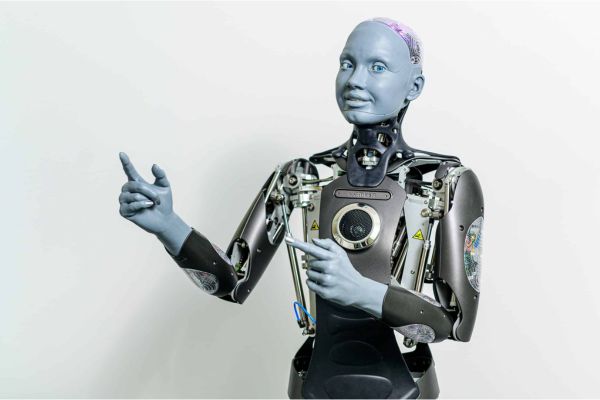According to Cervicorn Consulting, the global humanoid robot market size is expected to expand around USD 6.72 billion by 2034 and growing at a CAGR of 15.57% from 2025 to 2034. The humanoid robot industry continues to experience robust growth, driven by significant financial investment and rapid technological advancements. High levels of market funding reflect widespread confidence in the industry’s long-term potential, particularly in areas such as AI-related patents and innovations in mobility and interaction technologies. The integration of modern artificial intelligence—especially large language models (LLMs)—has significantly enhanced robotic intelligence and communication capabilities, paving the way for applications in healthcare, education, and manufacturing.
Falling production costs have made humanoid robots more accessible, encouraging broader adoption across various industries. Companies are increasingly targeting specialized use cases, such as eldercare in healthcare, interactive learning in education, and automation in manufacturing, to expand their market presence.
The Asia-Pacific region leads the way in humanoid robot development, with China and Japan at the forefront. In Europe, the focus is on human-centric design approaches. Meanwhile, major players like Tesla have entered the market, intensified competition and accelerating technological progress.
Market growth in the Asia-Pacific region is particularly driven by a rising elderly population, which is increasing demand for personal assistance and caregiving robots. Additionally, growing interest in educational and medical applications continues to fuel overall industry expansion.
Report Highlights
- North America led the humanoid robot market in 2024, capturing the largest revenue share of 47.50%.
- The Asia Pacific region accounted for a 27.80% revenue share in 2024 and is projected to experience the fastest growth over the forecast period.
- Based on motion type, the wheel-drive segment dominated the market in 2024, contributing 66% of total revenue.
- By component, the hardware segment held the leading position in 2024, securing a 68% revenue share.
- In terms of application, the personal assistance and caregiving segment accounted for 31.68% of the market revenue in 2024.
Market Dynamics
DRIVER: Increasing Adoption of Humanoid Robots in Education
The integration of humanoid robots into education represents a transformative approach to learning, enhancing student engagement and motivation. These robots are being utilized across diverse educational settings—including classrooms, extracurricular programs, and robotics competitions—to reshape teaching methods and workforce development initiatives. Universities also employ humanoid robots for research and academic purposes, supported by funding from organizations such as NASA, the National Science Foundation (NSF), and other global institutions.
Over the past decade, the educational use of humanoid robots has grown substantially, driven by the development of affordable platforms, user-friendly software, and programming tools. These advancements have made robotics more accessible to educators, students, and enthusiasts. Robotics-based curricula, particularly those emphasizing hands-on learning, interaction, and communication, are gaining popularity in schools and universities—even in early childhood education. As a result, the growing integration of humanoid robots in education is a key driver propelling market expansion.
RESTRAINT: Limited Performance in Unstructured Environments
Despite technological progress, humanoid robots still face performance challenges in dynamic, unstructured environments. Most current applications are limited to structured settings where interaction and tasks are predictable. As demand increases for robots in homes and public spaces, the need for adaptive behavior in complex surroundings grows.
Although features such as voice and facial recognition have been integrated, biped humanoid robots often struggle on unfamiliar terrain and underperform in unpredictable situations due to limited cognitive and decision-making capabilities. Failures in real-world operation reveal ongoing issues with programming, coordination, and information sharing among robots. The complexity of advanced robot designs further complicates performance prediction in new environments. These limitations pose a significant restraint on the widespread deployment of humanoid robots.
OPPORTUNITY: Expanding Role of Humanoid Robots in Logistics
The logistics sector presents a significant opportunity for humanoid robot adoption, offering potential to revolutionize operational efficiency. For instance, GXO Logistics partnered with robot manufacturer Apptronik in June 2024 to develop and deploy the Apollo humanoid robot across warehouse operations. This collaboration aims to tailor robotic solutions to the specific needs of logistics environments.
Humanoid robots are increasingly capable of handling complex tasks such as picking, packing, sorting, and unloading within warehouses. Advancements in AI and machine learning enable these robots to navigate dynamic environments, manage fragile items with precision, and perform various functions autonomously. Their ability to optimize inventory management and streamline shipping processes can reduce labor costs and address workforce shortages. This growing demand across sectors such as manufacturing, pharmaceuticals, automotive, and food & beverage creates new market opportunities for robot developers and suppliers.
CHALLENGE: Safety Concerns in Human-Centric Environments
Safety remains a critical challenge in the widespread adoption of humanoid robots, particularly in environments where they interact closely with humans. Accidents involving robots can lead to injuries and property damage, raising serious concerns about their safe integration into daily life.
Humanoid robots comprise complex systems with sensors, actuators, and moving components that can pose physical hazards. Ensuring safety requires robust features such as collision avoidance systems, emergency stop mechanisms, and adherence to safety standards. Regulatory bodies and research institutions are actively developing safety protocols and testing procedures to mitigate risks. To enable broader acceptance, it is essential to prioritize safety through rigorous risk assessments, continuous monitoring, and standardized design practices.
Segmental Analysis
Software Segment Expected to Record the Highest CAGR in the Humanoid Robot Market During the Forecast Period
The software segment is projected to exhibit the highest compound annual growth rate (CAGR) within the humanoid robot market over the forecast period. Software is the core that enables humanoid robots to perform specific tasks, comprising coded instructions and commands essential for robot programming. Robotic software functions much like an operating system, offering hardware abstraction, low-level device control, communication between processes, and package management services.
Several firms globally—ranging from startups to established players—are actively developing software solutions tailored for humanoid platforms. For example, Zora Robotics (Belgium) has created specialized software for SoftBank Robotics’ NAO robot. Similarly, Diatom Enterprises (Latvia) developed custom software for Pepper, a semi-humanoid robot by SoftBank Robotics (Japan). Another notable example is the Dynamixel SDK by ROBOTIS (South Korea), a robust toolkit for controlling Dynamixel actuators used in humanoid robotics.
Software also plays a critical role in enabling object manipulation. Through advanced algorithms, manipulation software allows humanoid robots to control arms, hands, and fingers with human-like precision, which is crucial for tasks requiring fine motor skills such as assembly, caregiving, and domestic work. As humanoid robots increasingly take on roles in hazardous environments and critical search operations, the demand for intelligent, adaptable software is expected to rise significantly.
Personal Assistance and Caregiving Segment to Hold the Largest Market Share by 2034
The personal assistance and caregiving segment is anticipated to dominate the humanoid robot market by 2034. Humanoid robots are being developed to function as personal aides, providing both physical support and emotional interaction, particularly for the elderly and individuals requiring regular assistance. These robots, capable of human-like interaction, are designed to interpret and respond to emotional cues, improving the quality of care provided.
Both bipedal and wheeled humanoid robots are used in caregiving environments. While bipedal robots offer greater mobility for household tasks, wheeled robots are practical and stable for indoor applications. Equipped with tools and interfaces designed for human use, these robots can perform routine caregiving duties such as administering medication, monitoring vital signs, assisting with meals, and alerting medical personnel in emergencies.
For instance, the NAO robot by SoftBank Robotics can recognize emotions and adjust its behavior accordingly, making it an effective companion in elderly care settings. In both homes and hospitals, humanoid robots are being increasingly adopted to alleviate the workload of caregivers and improve the quality of life for those needing assistance.
North America to Hold the Largest Market Share in 2024
North America—comprising the United States, Canada, and Mexico—is expected to lead the humanoid robot market in 2024. This dominance can be attributed to the strong presence of major robotics companies, distributors, and R&D institutions in the region. Technological advancements, especially in AI and robotics, along with growing demand for service robots in healthcare, are key drivers of market growth.
The U.S. is particularly prominent due to its robust innovation ecosystem and presence of key players such as Kindred Inc. and NASA. In North America, humanoid robots are deployed across a wide range of applications, including education, personal care, search and rescue, entertainment, and scientific research.
Furthermore, the aging population in the U.S. is increasing demand for robots in caregiving roles. At the same time, economic growth and rising concerns over human safety in hazardous environments are prompting industries to integrate humanoid robots into operational workflows. This convergence of demographic trends, technological readiness, and market need positions North America as a leading hub for humanoid robot adoption.
Buy this premium research report@ https://www.cervicornconsulting.com/sample/2505


















